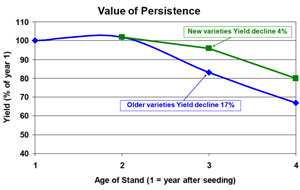This concept also applies to alfalfa stands. “An alfalfa stand technically can last 10 to 12 years,” according to PICKSEED’s Director of Western Canada Sales, Terry Scott. “However, yield potential declines with the age of the stand. The best yields are only visible for the first two to three years."
After this point, the stand starts to diminish and the question arises: “Do we rotate the alfalfa stand out next year in order to seed a new, higher yielding, and more persistent stand in two years time? Or do we hold onto this stand for one more year and hope for the best?”
The data in the table below shows the average yield of a typical alfalfa stand over its lifespan. The top of the graph shows the years when the greatest yields are expected, but as the age of the stand increases, persistence decreases, stands start to die out and ultimately lead to a decrease in profit.
From a cost perspective, the current alfalfa stand is depreciated over three years and is technically off the books, as an expense at year four, and is free for rotation at any time.
 An alfalfa stand leaves behind the perfect soil conditions to rotate into a profitable corn crop. The nitrogen credits that alfalfa leaves in the soil greatly reduce the input production costs for the first year of growing corn and can also increase corn yields by up to 10 percent. A once diminishing alfalfa stand can very quickly become a profitable field of corn.
An alfalfa stand leaves behind the perfect soil conditions to rotate into a profitable corn crop. The nitrogen credits that alfalfa leaves in the soil greatly reduce the input production costs for the first year of growing corn and can also increase corn yields by up to 10 percent. A once diminishing alfalfa stand can very quickly become a profitable field of corn.
Once the rotation returns to alfalfa, better persisting varieties that give a yield advantage in the first and second production years should be considered. When persistence starts to be an issue, typically in year three and beyond, these better varieties will provide a yield advantage in addition to a persistence advantage.
Even in the fifth and sixth production years, these improved varieties will give you considerably more yield than older varieties, as also shown on the table.
Looking from a cost perspective again, your seed purchase can be depreciated over more years than ever before. This equates to improved stands with improved yields costing less over time.
PICKSEED’s Director of Research Matt Anderson, reminds growers that just as cars start to wear down and mechanically deteriorate over time a number of problems will start to develop in an alfalfa stand. “As the age of an alfalfa stand increases, the persistence of the stand decreases along with yield, winter hardiness and forage quality.”
It is time to start shopping for alfalfa with a similar mindset of shopping for a vehicle; purchase a variety that is reliable, hardworking and proven to last. You might pay more at the initial time of purchase but over the lifespan of the stand the yield advantage and persistence advantage will pay for itself two-fold. FG
—Excerpts from Saskatchewan Forage Council eNews, Vol. 3, No. 4
PHOTO
TOP RIGHT: Alfalfa. Photo and table courtesy of The Pickseed Companies Group.










